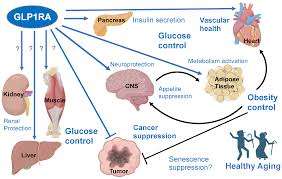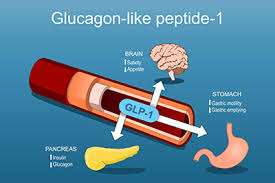The fight against obesity has long been a priority for healthcare professionals and individuals alike, as excess weight is linked to numerous health complications, including diabetes, cardiovascular diseases, and hypertension.
Among the array of treatments, GLP-1 receptor agonists have emerged as a groundbreaking solution for aiding weight loss.
These medications, initially developed to manage Type 2 diabetes, are now recognized for their significant impact on body weight regulation.
In this article, we will explore the mechanisms behind how GLP-1 receptor agonists aid in weight loss, backed by scientific research, real-life examples, and clear insights into why these medications have garnered so much attention.
Table of Contents
- Introduction to GLP-1 and Its Role in the Body
- Mechanisms of GLP-1 Receptor Agonists in Weight Loss
- 2.1. Appetite Suppression and Satiety Regulation
- 2.2. Delayed Gastric Emptying
- 2.3. Effects on Reward Pathways and Food Cravings
- Why GLP-1 Receptor Agonists Are Effective for Obesity
- 3.1. Hormonal Modulation and Energy Balance
- 3.2. Real-World Efficacy: Clinical Studies
- Real-Life Examples of Success with GLP-1 Receptor Agonists
- 4.1. Case Study: Sarah’s Weight Loss Journey
- 4.2. Case Study: John’s Improved Health Metrics
- FAQs on GLP-1 Receptor Agonists and Weight Loss
- Conclusion
Introduction to GLP-1 and Its Role in the Body
Glucagon-like peptide-1 (GLP-1) is a key hormone secreted by the intestinal cells in response to food intake.
This hormone plays a crucial role in glucose metabolism by enhancing insulin secretion from the pancreas, suppressing the release of glucagon (which raises blood sugar levels), and promoting a sense of satiety to regulate appetite.
These combined effects help maintain balanced blood sugar levels and prevent overeating.
Recognizing these multifunctional benefits, researchers developed GLP-1 receptor agonists— (weight loss medication) that mimic the natural hormone’s action by binding to GLP-1 receptors throughout the body.
These agonists were initially approved for managing blood sugar levels in Type 2 diabetes patients. However, clinical trials and real-world observations revealed that GLP-1 receptor agonists also have profound effects on weight loss.
By suppressing appetite and slowing gastric emptying, they reduce caloric intake, making them effective for both diabetes management and obesity treatment, offering hope to millions struggling with these conditions.

Mechanisms of GLP-1 Receptor Agonists in Weight Loss
Here is how this process takes shape:
Appetite Suppression and Satiety Regulation
One of the primary ways GLP-1 receptor agonists aid in weight loss is by influencing hunger and satiety signals.
These medications activate GLP-1 receptors in the hypothalamus, the brain’s hunger control center, reducing appetite and increasing feelings of fullness.
A study published in The Lancet Diabetes & Endocrinology (Blundell et al., 2017) showed that individuals on GLP-1 receptor agonists consumed fewer calories at meals, resulting in gradual and sustainable weight loss.
For example, participants who used liraglutide, a GLP-1 receptor agonist, reported feeling satiated earlier during meals and had reduced overall caloric intake without conscious effort.
Delayed Gastric Emptying
GLP-1 receptor agonists slow down the rate at which the stomach empties its contents into the small intestine.
This delayed gastric emptying prolongs the sensation of fullness, reducing meal frequency and portion sizes.
For instance, someone taking semaglutide—a widely prescribed GLP-1 receptor agonist—may find themselves eating smaller meals throughout the day, as their stomach remains fuller for longer periods.
This mechanism not only supports calorie reduction but also helps regulate post-meal blood sugar levels, further contributing to metabolic health.
Effects on Reward Pathways and Food Cravings
Beyond physical satiety, GLP-1 receptor agonists impact reward-related eating behaviors. They interact with dopamine pathways in the brain, reducing the pleasure derived from high-calorie foods.
In a study published in Nature Medicine (van Bloemendaal et al., 2014), researchers observed that patients taking GLP-1 receptor agonists showed decreased cravings for fatty and sugary foods.
This reduced reward-seeking behavior helps break the cycle of emotional or impulsive eating, which is a significant contributor to weight gain.
Why GLP-1 Receptor Agonists Are Effective for Obesity?
A quick look at how and why they are an effective weight loss strategy:
Hormonal Modulation and Energy Balance
GLP-1 receptor agonists not only suppress appetite but also influence other hormones involved in energy homeostasis.
For example, they reduce levels of ghrelin, the hunger hormone, while increasing peptide YY (PYY), which signals satiety.
This hormonal balance creates an environment conducive to weight loss without the need for extreme dieting.
A review in Obesity Reviews (Astrup et al., 2018) emphasized that these hormonal changes enhance the body’s ability to burn fat while preserving lean muscle mass, making weight loss through GLP-1 receptor agonists healthier and more sustainable.
Real-World Efficacy: Clinical Studies
Several clinical trials have highlighted the effectiveness of GLP-1 receptor agonists for weight loss. The STEP 1 trial, published in The New England Journal of Medicine (Wilding et al., 2021), evaluated semaglutide’s weight-loss effects in overweight and obese individuals.
Participants experienced an average weight reduction of nearly 15% over 68 weeks, significantly outperforming the placebo group.
These results underscore the transformative potential of GLP-1 receptor agonists as a cornerstone in obesity treatment.
>>> Want to Lose Weight Like I Did??? Check Out My “Secret Fat Loss Smoothie Recipe” TODAY! <<<
FAQs on GLP-1 Receptor Agonists and Weight Loss
Q-1: By what specific mechanisms do GLP-1 receptor agonists drive weight loss?
A-1: They reduce energy intake through two main levers: brain satiety pathways (you feel full sooner, with fewer cravings) and slower gastric emptying (meals stay in the stomach longer, flattening post-meal hunger). They also nudge metabolic signaling in liver and fat toward less storage. The dominant effect is eating less—at meals and snacks—so total weekly calories fall without constant white-knuckle restraint.
Q-2: How much weight loss is typical with modern GLP-1 therapies alongside lifestyle changes?
A-2: Large trials show double-digit average losses over a year or more when a full, labeled dose is paired with nutrition, physical activity, and behavioral support. Typical results include many people reaching 10–15% total body weight reduction, with a subset exceeding that. Results vary by dose, adherence, side-effect management, and the consistency of habits built around the medication.
Q-3: What happens to body composition—do you only lose fat?
A-3: Most of the lost weight is fat mass, including reductions in deep (visceral) fat that’s strongly linked to cardiometabolic risk. Some lean mass usually declines too—as it does with most weight-loss approaches—but the lean-to-fat ratio often improves. You can protect lean tissue by prioritizing protein (roughly 1.6–2.2 g/kg ideal body weight/day, individualized) and doing resistance training 2–3 times per week.
Q-4: Do results persist if you stop the medication?
A-4: Weight regain is common after discontinuation because appetite signals and gastric emptying speed tend to revert. Many people regain a substantial portion of the lost weight within months if nothing changes. Long-term success improves when you keep the habits you practiced on-treatment—structured meals, protein targets, step goals, and brief resistance sessions—and consider ongoing medical therapy if appropriate.
Q-5: What practical safety and usage tips improve real-world outcomes?
A-5: Titrate slowly to reduce nausea, and eat smaller, protein-forward meals; pause dose escalations during intercurrent illness. Stay hydrated, especially if you have GI side effects. Tell your clinician about gallbladder disease, pancreatitis history, severe GI disorders, or plans for pregnancy. Review other glucose-lowering drugs to avoid hypoglycemia, and set a maintenance plan early (nutrition, activity, sleep, stress skills) so progress doesn’t depend on the prescription alone.
Real-Life Examples of Success with GLP-1 Receptor Agonists
We would like to share 2 such examples that are sure to capture your attention:
Discussing Sarah’s Weight Loss Journey:
Sarah, a 38-year-old nurse, had spent most of her adult life wrestling with obesity.
She tried every diet under the sun—low-carb, intermittent fasting, calorie counting—but no matter how hard she worked, the persistent hunger and emotional eating always seemed to get the better of her.
It was frustrating and disheartening, especially for someone juggling a demanding career in healthcare.
Everything changed when her doctor prescribed liraglutide. At first, Sarah was skeptical; could a medication really make a difference?
But within weeks, she noticed a remarkable shift. Her appetite decreased, and the constant cravings for sugary snacks and comfort foods seemed to vanish.
Six months later, Sarah had lost an impressive 30 pounds. She felt lighter, both physically and emotionally.
The newfound energy helped her tackle her long shifts, and her confidence soared.
Liraglutide didn’t just suppress her hunger; it empowered her to adopt sustainable lifestyle changes that finally made weight management achievable.
Sarah’s story is a testament to the transformative potential of GLP-1 receptor agonists in supporting long-term weight loss.
Sharing John’s Improved Health Metrics:
Meet John, a 55-year-old diabetic who thought he was just signing up for better blood sugar management when he started semaglutide.
Little did he know, he was also enrolling in the “Drop the Pounds” program!
Within just four months, John had shed an impressive 25 pounds—completely unexpectedly. It wasn’t magic; it was science working double duty.
As the weight came off, the benefits piled on.
His blood pressure, which had been creeping into the danger zone, dropped to healthier levels. His HbA1c, the measure of long-term blood sugar control, took a nosedive too—much to his doctor’s delight.
John’s experience is a testament to the multifaceted power of GLP-1 receptor agonists.
These medications are not just single-taskers; they’re the Swiss Army knives of metabolic health, tackling blood sugar, weight, and even cardiovascular risk all at once.
For John, semaglutide turned out to be more than a prescription—it was a life-changer.
FAQs on GLP-1 Receptor Agonists and Weight Loss

Conclusion
GLP-1 receptor agonists have revolutionized the approach to weight management by leveraging natural hormonal pathways to reduce appetite, delay gastric emptying, and curb food cravings.
Their ability to address both physical and behavioral aspects of eating makes them an effective tool for sustainable weight loss.
Scientific studies and real-life experiences, such as Sarah’s and John’s, highlight their transformative impact on individuals struggling with obesity and related metabolic disorders.
Understanding the mechanisms behind GLP-1 receptor agonists not only underscores their effectiveness but also paves the way for further research into personalized obesity treatments.
These medications mark a significant step forward in tackling one of the most pressing health challenges of our time.
References: